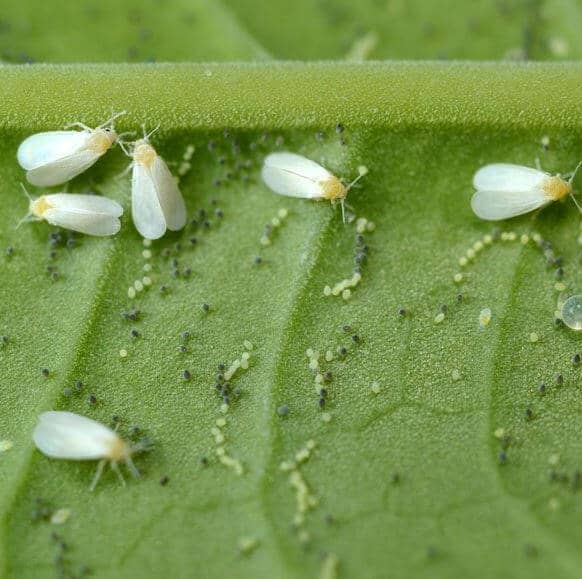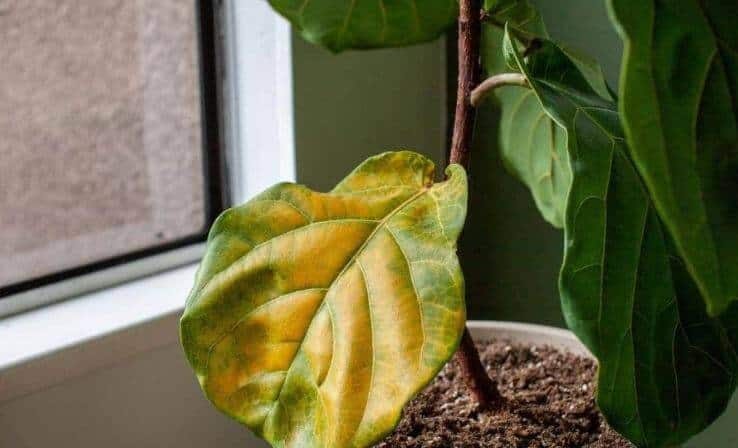Last Updated on August 3, 2023 by a Friendly Gardener
Fiddle-leaf fig plants cast a special aura that is especially attractive to pests. All houseplants are potential sources of food and breeding grounds for pests, but fiddle leaf figs seem to be magnets for pests like spider mites, scale, and mealybugs. Yet another particularly pesky pest is the fungus gnat, and gnats will bother you as much as they bother your plant.
Fungus gnats are minuscule flies that will move around a fig’s foliage and deposit their eggs in the soil. While an adult fungus gnat is not harmful, it most certainly can be annoying. The challenge that these flies pose to your fiddle leaf fig plant is through the eggs they deposit. Eggs are laid in the soil so that when they hatch and develop into larvae, the larvae can feed on the plant’s root system. When left unattended, this nibbling will damage the root system, causing leaves to yellow. They also can infect your plant with diseases when infestations are severe.
Fiddle leaf fig fruit flies are really fungus gnats. They love moist potting soil, so expect to see them moving about close to your plant’s base.
Preventing Flies in Fiddle Leaf Fig Plants

-
Examine new Fiddle Leaf Fig plants

The techniques used to prevent fungus gnats from taking u residence in your fiddle leaf fig plant will also prevent other kinds of pest infestations. When purchasing a fiddle leaf fig, examine the plant closely before purchasing it to bring home or to the office.
If you want to check for fungus gnats, just poke the soil around the plant’s base. By moving the soil around a bit with your finger, you should be able to see any larvae that are wiggling about in the potting soil used. If you see gnat larvae or adults, select another plant. Do not acquire a plant with evident signs of a fungus gnat presence. Check neighboring plants as well, as these pests spread quickly and easily.
-
Isolate new Fiddle Leaf Fig plants
Whenever you bring a new plant home, isolate it for the first several days or even weeks, as all pests spread quickly from one plant to the next.
-
Repotting a Fiddle Leaf Fig plant

Once you have acquired your new plant, you may decide to repot it in a larger or more decorative container. Use clean, sterilized pots and fresh new potting soil of good quality. Fungus gnat eggs may remain attached to old pots or in old potting soil. If you suspect that your potting soil may be the source of fungus gnat reproduction, toss the soil and acquire a new bag of soil.
-
Supply your Fiddle Leaf Fig with generous amounts of sunlight
Fungus gnats prefer damp, dark environments, so place your Fiddle Leaf Fig in a spot where your plant will receive lots of bright but indirect sunlight. This will act as a deterrent.
-
Avoid Overwatering your Fiddle Leaf Fig
When potting soil is overly wet, it will appeal to fungus gnats as a place to deposit eggs. While your plant does need water to survive, it does not need to sit in soggy soil. Water sparingly when the top two to three inches are dry. If you have trouble evaluating your plant’s water needs, use a moisture meter. Take care to use potting soil that is loose and well-draining. These little flies prefer soils that have high water retention capabilities. Cactus soil is a good option or mix one part potting soil with one part cactus or succulent soil mix. Avoid using compost or peat-based potting soil.
Eliminating Fruit Flies on Fiddle Leaf Fig Plants

If your Fiddle Leaf Fig plant is already infested with fungus gnats, try these methods to eliminate them from your plant.
-
Repot your Fiddle Leaf Fig Plant
This method is particularly effective if your plant appears to be healthy. It is the easiest and most definite method for eliminating the fungus gnat eggs buried in the soil. This will also resolve overwatering issues or if your plant is rootbound. Select a new sterilized, clean container. If you wish to use the same pot, make it a point to sterilize it before reusing the pot, and use new, fresh potting soil.
-
Remove the top several inches of your plant’s potting soil
This option is less radical than repotting. Scoop or spoon out the top several inches of soil from the container. This should remove eggs and larvae hidden in the soil. Dispose of the old soil to impede the fungus gnats to continue to develop and reproduce.
-
Add in Good Bacteria
BTI also known as Bacillus thuringiensis is a non-toxic, harmless bacteria for humans and pets, but it is highly toxic to insects and larvae. This bacterium is used in organic cultivation and farming as a natural insecticide. Sprinkle the soil surface with BTI.
-
Use Sticky Traps or Fly Paper
Adult fungus gnats naturally die within a few weeks, and if no eggs are hatching, this will end the infestation. To speed up the process, place flypaper or sticky traps at the base of the plant or hang them from the plant.
-
Sprinkle Diatomaceous earth on your plant’s soil surface

Diatomaceous earth is a mineral in powdered form. It is characterized by sharp edges. While this mineral is harmless to your plant, it will kill any pests, including fungus gnats when they eat it. If you choose to use this mineral, wear a mask during application and apply the powder outside if possible.
-
Try Neem oil
You can also try spraying organic neem oil on the soil surface, although you may need to move the soil around a bit and apply it more than once. Neem oil is a natural oil that is not harmful to humans or animals.
Pests are a problem for all houseplants and fungus gnats while they may appear harmless can wreak havoc on your Fiddle Leaf Fig’s root system. Use one of the above methods to rid your plants of these bothersome flies and protect them.

